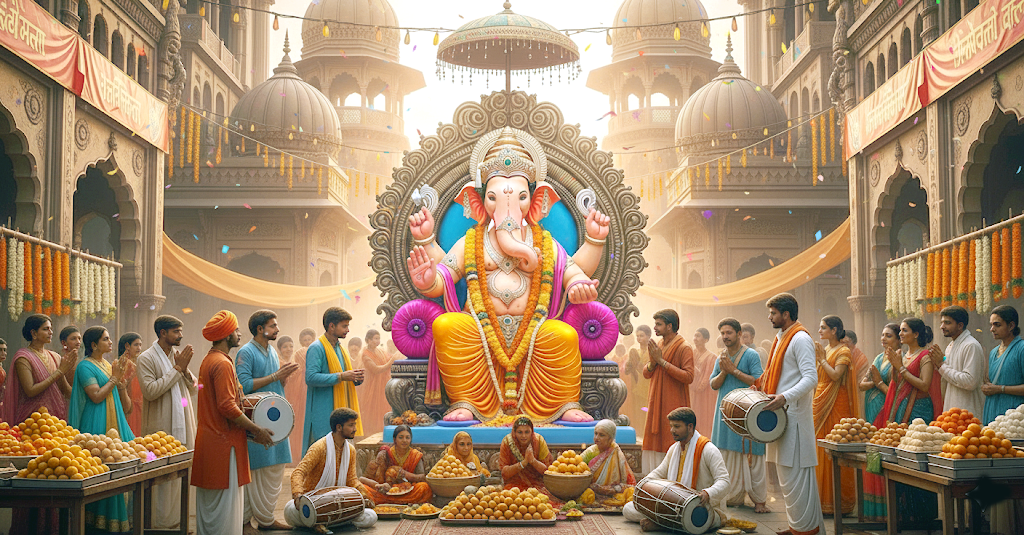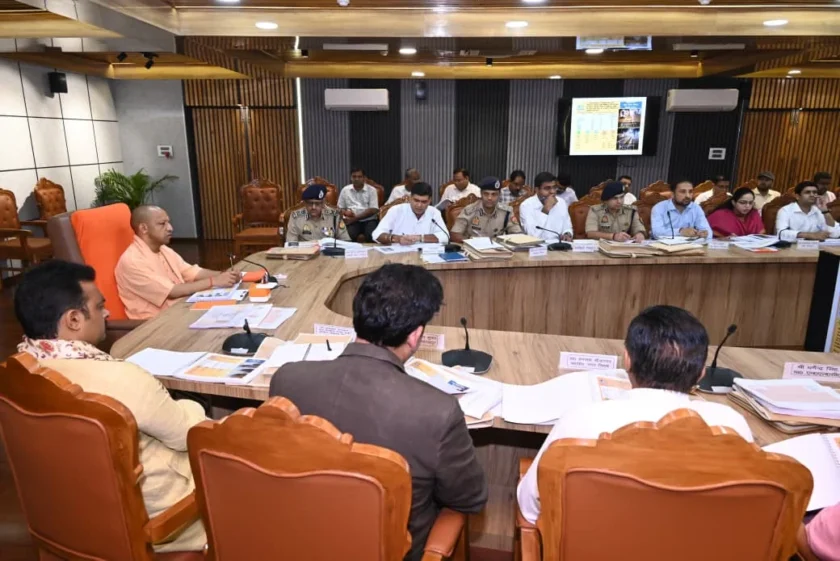Lucknow: Lucknow, the city of nawabs, is known for its rich cultural heritage and syncretic traditions. During Ganeshotsava, the festival for Lord Ganesha, the remover of obstacles, the city transforms into a vibrant hub of devotion and celebration. This annual Hindu festival, celebrated across India, holds a special place in the hearts of Lucknowites, who embrace it with a unique blend of traditional rituals, modern enthusiasm, and communal harmony. From intimate domestic settings to grand public pandals, the city comes alive with the rhythmic chants of “Ganpati Bappa Morya,” colorful decorations, and a shared spirit of joy that transcends social and cultural boundaries.
Ganeshotsava in Domestic Settings
The celebration of Ganeshotsava in Lucknow begins in homes, where families create sacred spaces to welcome Lord Ganesha. The festival, typically spanning five to ten days, starts with the installation of Ganesha idols. These idols, which can range from small clay figures to intricately crafted larger statues, are adorned with vibrant garlands, jewelry, and clothes. Homes are meticulously cleaned and decorated with rangolis, mango leaves, and fairy lights to create an auspicious ambiance. The air fills with the fragrance of incense sticks, fresh flowers, and the aroma of traditional sweets like modaks, Ganesha’s favorite offering. As one resident of Gomti Nagar shared, “The festival is a deeply personal experience for our family. It’s a time to reconnect with our roots and teach our children the importance of faith and tradition.”
Domestic celebrations are deeply rooted in rituals. Families perform the pranapratishtha ceremony, invoking life into the idol, followed by daily aartis (prayer rituals) accompanied by devotional songs and bhajans. The rhythmic clanging of cymbals and the soulful recitation of Ganesh Atharvashirsha resonate through homes, fostering a sense of spiritual connection. In many households, especially in neighborhoods like Gomti Nagar, Aliganj, and Hazratganj, families invite priests to conduct elaborate pujas, while others opt for simpler, heartfelt rituals. Women often take the lead in preparing prasad (offerings) such as ladoos, kheer, and puran poli, which are shared among neighbors and relatives, strengthening community bonds.

Children play a significant role in domestic celebrations, eagerly participating in decorating the idol and reciting shlokas. For many, it’s a time to learn about cultural traditions and values as parents narrate stories of Ganesha’s wisdom and benevolence. The festival also becomes an occasion for family gatherings, with relatives visiting to offer prayers and partake in feasts. In Lucknow’s multicultural ethos, non-Hindu neighbors often join in, sharing sweets and exchanging greetings and embodying the city’s Ganga-Jamuni tehzeeb—a harmonious blend of Hindu and Muslim traditions.
Public Pandals: A Grand Spectacle
While domestic celebrations are intimate, the public pandals of Lucknow elevate Ganeshotsava to a grand, communal spectacle. Across the city, in areas like Aminabad, Mahanagar, Nishatganj, and Jankipuram, vibrant pandals spring up, drawing thousands of devotees and visitors. These pandals, often organized by local committees, cultural organizations, or youth groups, compete to create the most awe-inspiring setups, combining creativity, artistry, and devotion.
The pandals are a visual treat, featuring towering Ganesha idols, some as tall as 15-20 feet, adorned with shimmering ornaments and surrounded by elaborate thematic decorations. Themes range from traditional depictions of Ganesha’s divine abode to contemporary issues like environmental conservation or recreations of famous temples. As a pandal organizer in Hazratganj noted, “Our goal is to create a powerful experience for everyone who visits. We use our pandal to convey a social message, whether it’s about saving the environment or promoting unity.” These setups often incorporate LED lights, sound systems, and even eco-friendly materials, reflecting a growing consciousness toward sustainability.
The pandals serve as cultural hubs, hosting a variety of events throughout the festival. Devotees throng to offer prayers, while evenings come alive with devotional music concerts, dance performances, and bhajans. Local artists and renowned musicians perform, adding to the festive fervor. In some pandals, organizers arrange satsangs (spiritual discourses) and charity drives, distributing food and clothes to the underprivileged, aligning with Ganesha’s ethos of compassion.

The public celebrations are incomplete without the iconic Ganesh Visarjan processions, marking the culmination of the festival. On the final day, usually the Anant Chaturdashi, devotees carry Ganesha idols through the streets in grand processions, accompanied by dhol-tasha beats, dance troupes, and enthusiastic chants. In Lucknow, these processions wind through key routes like the Gomti Riverfront or Parivartan Chowk, with thousands joining in to bid farewell to Ganesha. The immersion rituals, performed in the Gomti River or designated water bodies, are both solemn and celebratory as devotees pray for Ganesha’s return the following year.
A Blend of Tradition and Modernity
Lucknow’s Ganeshotsava is a beautiful amalgamation of tradition and modernity. While the rituals remain steeped in ancient practices, the festival has evolved to reflect contemporary sensibilities. Many households and pandals now opt for eco-friendly idols made of clay or natural materials, responding to environmental concerns about plaster-of-Paris idols and chemical paints. Social media plays a significant role, with pandal organizers live-streaming aartis and events, enabling devotees from across the globe to participate virtually.
The festival also fosters inclusivity. In a city known for its communal harmony, Ganeshotsava sees participation from people of all faiths. Muslim artisans in areas like Chowk craft Ganesha idols, while interfaith communities collaborate to organize pandal events. This spirit of unity is evident in initiatives like “Sarvajanik Ganeshotsav Samitis,” which bring together diverse groups to celebrate the festival. A local community leader stated, “This festival is a true reflection of our city’s spirit. It’s a testament to how people of different backgrounds can come together to celebrate with a shared sense of joy and respect.”
Economic and Social Impact
Ganeshotsava also boosts Lucknow’s local economy. Artisans, florists, sweet makers, and decorators witness a surge in demand, while temporary stalls selling puja items, idols, and street food thrive around pandals. The festival creates employment opportunities for artists, musicians, and laborers involved in pandal setup and processions.
Socially, Ganeshotsava strengthens community ties. Neighborhoods come together to organize pandals, pooling resources and efforts. Youth groups take on responsibilities like crowd management and eco-friendly initiatives, fostering leadership and civic engagement. The festival also provides a platform for social messages, with pandals often highlighting issues like women’s empowerment, education, or cleanliness drives.
Ganeshotsava in Lucknow is more than a religious festival; it’s a celebration of faith, culture, and community. From the intimate devotion of home rituals to the grandeur of public pandals, the city embraces Lord Ganesha with open hearts, blending tradition with modernity. The festival’s vibrant processions, soulful prayers, and shared joys reflect Lucknow’s unique charm—a city where heritage and harmony coexist. As the chants of “Ganpati Bappa Morya” echo through its streets, Lucknow comes alive, united in devotion and celebration, creating memories that linger long after the idols are immersed.





